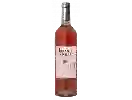
Domaine de la CadenetteSiracanta
In the mouth this red wine is a powerful with a nice balance between acidity and tannins.
This wine generally goes well with beef, game (deer, venison) or lamb.
The Siracanta of the Domaine de la Cadenette is in the top 90 of wines of Costières-de-Nîmes.
Taste structure of the Siracanta from the Domaine de la Cadenette
Light | Bold | |
Smooth | Tannic | |
Dry | Sweet | |
Soft | Acidic |
In the mouth the Siracanta of Domaine de la Cadenette in the region of Rhone Valley is a powerful with a nice balance between acidity and tannins.
Wine flavors and olphactive analysis
On the nose the Siracanta of Domaine de la Cadenette in the region of Rhone Valley often reveals types of flavors of vanilla, non oak or oak and sometimes also flavors of spices.
Food and wine pairings with Siracanta
Pairings that work perfectly with Siracanta
Original food and wine pairings with Siracanta
The Siracanta of Domaine de la Cadenette matches generally quite well with dishes of beef, lamb or game (deer, venison) such as recipes of tata simone's dumplings, lamb garam massala or deer stew.
Details and technical informations about Domaine de la Cadenette's Siracanta.
Discover the grape variety: Melon blanc et rouge
Very old Burgundian grape variety. According to published genetic analyses, it is the result of a natural cross between Pinot and Gouais, which are the same parents of Gamay. Melon can be found in Germany, Croatia, Bulgaria, ... in France it is nowadays mostly multiplied in the Loire Valley, registered in the Official Catalogue of wine grape varieties, list A1.
Last vintages of this wine
The best vintages of Siracanta from Domaine de la Cadenette are 2013, 2017, 2014, 2016 and 2015.
Informations about the Domaine de la Cadenette
The Domaine de la Cadenette is one of of the world's greatest estates. It offers 9 wines for sale in the of Costières-de-Nîmes to come and discover on site or to buy online.
The wine region of Costières-de-Nîmes
The wine region of Costières-de-Nîmes is located in the region of Rhône méridional of Rhone Valley of France. Wineries and vineyards like the Domaine Scamandre or the Château d'Or et de Gueules produce mainly wines red, pink and white. The most planted grape varieties in the region of Costières-de-Nîmes are Mourvèdre, Roussanne and Viognier, they are then used in wines in blends or as a single variety. On the nose of Costières-de-Nîmes often reveals types of flavors of non oak, thyme or raisin and sometimes also flavors of clove, cocoa or coffee.
The wine region of Rhone Valley
The Rhone Valley is a key wine-producing region in Southeastern France. It follows the North-south course of the Rhône for nearly 240 km, from Lyon to the Rhône delta (Bouches-du-Rhône), near the Mediterranean coast. The Length of the valley means that Rhône wines are the product of a wide variety of soil types and mesoclimates. The viticultural areas of the region cover such a distance that there is a widely accepted division between its northern and southern parts.
The word of the wine: Consistency
In tasting, it is the equivalent of chewing (the chewiness of a tannic red wine is also mentioned). We then speak of firmness, fluidity, softness, hardness, and why not the crunchiness of an early wine by reference to the grape.













